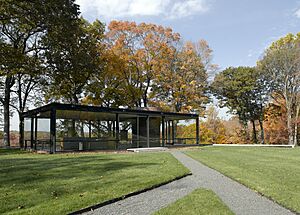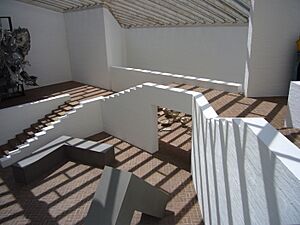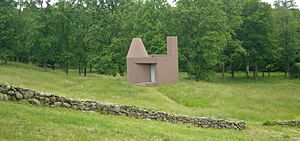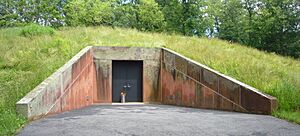Glass House facts for kids
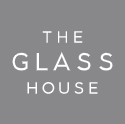 |
|
 |
|
| Location | 798–856 Ponus Ridge Road, New Canaan, Connecticut |
|---|---|
| Public transit access | |
The Glass House (also called the Johnson House) is a famous historic house museum in New Canaan, Connecticut. It was built in 1948–49. The well-known architect Philip Johnson designed it as his own home. Many people consider the Glass House to be his most important work.
The Glass House is a great example of modern architecture. It shows how buildings can use simple shapes and clear materials like glass. The house is also known for its transparency, meaning you can see right through it. This design lets the surrounding nature become part of the house's look.
The estate includes other buildings designed by Johnson. These buildings show how his ideas changed over time. In 1997, the Glass House was named a National Historic Landmark. Today, the National Trust for Historic Preservation owns it. You can visit the Glass House on guided tours. These tours start at a visitor center in New Canaan.
The house was one of the first homes to use industrial materials like glass and steel. Philip Johnson lived there for 58 years. His partner, David Whitney, helped design the outdoor areas. He also collected much of the art displayed there.
Contents
What Makes the Glass House Special?
The Glass House is mostly hidden from the street. It sits behind a stone wall on a hill. From there, it looks over a pond. Paths of grass and gravel lead to the building.
The house is about 56 feet (17 meters) long. It is 32 feet (9.8 meters) wide and 10.5 feet (3.2 meters) high. The main room has areas for cooking, eating, and sleeping. All these areas are inside one glass-enclosed space. Johnson first lived here, along with a nearby brick guest house. Later, the glass building was used mostly for parties.
The outside of the Glass House uses steel painted charcoal gray and large glass panels. The floor is made of brick and is 10 inches (25 cm) above the ground. Inside, the space is open. Low walnut cabinets divide the different areas. A brick cylinder holds the bathroom. This is the only part that goes from the floor to the ceiling.
How the Design Was Inspired
The house's design uses ideas from German architects of the 1920s. They explored "Glasarchitektur," or "glass architecture." Johnson once said that the views of the landscape were his "very expensive wallpaper."
Johnson was also inspired by Ludwig Mies van der Rohe's Farnsworth House. Even though the Glass House was finished earlier, many saw it as similar to Mies's design. Johnson had even shown a model of the Farnsworth House at a museum exhibit in 1947. The Glass House also has furniture designed by Mies.
Philip Johnson once said his idea for the Glass House came from seeing a "burnt wooden village." He described how only the foundations and brick chimneys were left.
The Landscape Around the House
The beautiful outdoor areas around the buildings were designed by Johnson and Whitney. They created neat areas of gravel and grass. Trees were grouped to form outdoor "rooms." They also carefully shaped the hills and curves of the ground.
The landscape was partly inspired by a painting called The Funeral of Phocion. This painting was by an artist from the school of Nicolas Poussin. Johnson designed the views through the glass walls to look like the painting. The estate looks over the Rippowam River valley to the west. The slopes to the north and south also look like parts of the painting.
The Glass House Through Time
Philip Johnson's Life at the House
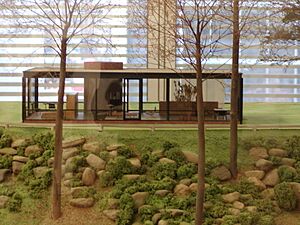
Johnson spent three years designing the Glass House. It was one of two main buildings on his property. The other was the brick guest house.
The Glass House made Philip Johnson famous. Not just among architects, but with the public too. It was featured in Life magazine and the New York Times Magazine. The house helped make modern architecture popular. Johnson became known as a leader of the Modernist style.
The house caused so much excitement that a police officer was once stationed nearby. This was to keep people from trespassing. Johnson even put up a sign asking people to respect his privacy. A critic from the New York Times said the Glass House was "once one of the most famous houses in the United States."
Johnson had a complex past before he became an architect. He later left that past behind and focused on architecture. He joined architecture school in 1940.
For many years, students from Yale University would try to sneak onto the property. It was a kind of tradition for them. They would see how long they could explore before David Whitney found them and asked them to leave.
After Johnson's Time
Johnson wanted his estate to be a public place. He even built a building called Da Monsta to be a visitor center. However, after he passed away, officials decided to build the visitor center in downtown New Canaan instead.
The Glass House was named a National Historic Landmark in 1997. Philip Johnson passed away at the house on January 25, 2005, at 98 years old. His partner, David Whitney, passed away later that same year. Whitney left money to help keep the site running.
Johnson gave ownership of the Glass House to the National Trust for Historic Preservation. It opened to visitors in April 2007. The trust bought more land, making the property much larger. When tours first started in 2007, tickets sold out quickly. By July 2010, 15,000 people had visited. The Brick House, the guest house, was closed for renovations in 2008. It reopened in May 2024.
Other Buildings on the Estate
Johnson's large estate has 14 other buildings he designed. These include:
- The "Brick House" (1949–1950), which is a guest house.
- The Pavilion on the Pond (1962).
- The Painting Gallery (1965), which holds 20th-century American art.
- The Sculpture Gallery (1970), also with 20th-century American art.
- The Study (1980).
- The Ghost House (1982).
- The Kirstein Tower (1985), named after his friend, dance choreographer Lincoln Kirstein.
- "Da Monsta" (1995).
The buildings on the property have different shapes. Some are rectangular, and some are circular. The Glass House is rectangular, but it has a round brick fireplace inside. The Brick House is also rectangular. However, a round concrete sculpture by Donald Judd and small round pools nearby make the area feel softer.
Some buildings had specific uses. The Glass House was for entertaining. The Study was for work. The galleries were for storing and showing art. Johnson called some buildings his "follies." This is because their size or shape made them hard to use. Examples include the low-ceilinged Pavilion on the Pond or the Ghost House. The Ghost House is made of chain-link fencing on an old barn's foundation. It has lilies planted inside. Johnson also remodeled three other houses on the estate.
The Painting Gallery
The Painting Gallery building is built underground. Its entrance looks like the ancient Tomb of Agamemnon. Inside, large 20th-century paintings are displayed. These include works by Frank Stella, Robert Rauschenberg, Julian Schnabel, Andy Warhol, and Cindy Sherman. The paintings are on three spinning racks covered in carpet.
Johnson and Whitney collected many artworks over 40 years. They gave much of it to the Museum of Modern Art during their lives. The gallery still has an 8-foot tall portrait of Johnson by Andy Warhol. It shows the same thoughtful image of the architect nine times. Whitney, who was an art curator, helped choose the art collection.
Da Monsta
The red and black "Da Monsta" building has no right angles. It is made from a special concrete called gunite. It is one of the few buildings you can see from the road. Near it is a 20-foot (6.1 m) high entrance gate. This gate is made from a sailboat part.
In a 1997 film, Philip Johnson talked about the buildings on his property. He called them his "diary." He focused on "Da Monsta," which was the newest building then. Johnson was friends with architects Frank Gehry and Peter Eisenman. Their influence can be seen in Da Monsta's shape. Johnson said his idea for Da Monsta came from a museum design by his artist friend Frank Stella. He even named an early model "Dresden Zwei," or "Dresden Two," after Stella.
Visiting the Glass House

Tour groups are small, with only 15 people. The tour includes a 3/4 mile (1.2 km) walk through the estate. Tours start and end at the Visitor Center in downtown New Canaan, Connecticut. From there, vehicles take each group to the Glass House site.
"Standard" tours last 90 minutes. You are not allowed to use flash photography. There is also a "pure glass" tour that only visits the Glass House and lasts one hour. Longer tours are two hours and cost more. Tours at sunset and "personalized" tours are also available. Special events include picnics and film festivals. There are also talks with famous people in architecture and design. These talks happen inside the Glass House for a limited number of guests.
The Visitor Center is designed to match Johnson's simple style. It has a "media wall" with 24 computer screens. These screens show many videos at once. The videos highlight different parts of the estate. This includes the architecture, art, and landscaping. Each screen shows a different theme. They also feature quotes from Johnson, Whitney, or their friends.
Besides regular tours, special tours are offered for architects. There are also tours for artists and museum curators. These special tours might spend more time in the Painting Gallery and Sculpture Gallery.
Images for kids
See also
 In Spanish: Casa de Cristal para niños
In Spanish: Casa de Cristal para niños


